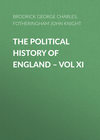Kitabı oku: «The Political History of England – Vol XI», sayfa 33
CHAPTER XX.
LITERATURE AND SOCIAL PROGRESS
The period which elapsed between the resignation of Pitt and the battle of Waterloo was hardly less eventful in the history of British civilisation than in the history of British empire. To some, the boundary line between the society of the eighteenth and that of the nineteenth century appears to be marked by the outbreak of the French revolution, and the far-reaching effects of that catastrophe upon ideas, manners, and politics in Great Britain, as well as upon the continent, are too evident to be denied. But it is equally certain that, before the French revolution, an intellectual and industrial movement was in progress which must have given a most powerful impulse to civilisation, even if the French revolution had never taken place. In this country, especially, the great writers, philanthropists, scientific leaders, inventors, engineers, and reformers of various types, who adorned the latter part of George III.'s reign, largely drew their inspiration from an age, just preceding the French revolution, which is sometimes regarded as barren in originality.
When the nineteenth century opened, the classical authors of that pre-revolutionary age had mostly passed away. Hume died in 1776, Johnson in 1784, Adam Smith in 1790, Gibbon in 1794, Burns in 1796, Burke in 1797, Cowper in 1800. John Howard, the great pioneer of prison reform, became a martyr to philanthropy in 1790. The most remarkable of those manufacturing improvements and mechanical inventions upon which the commercial supremacy of England is founded date from the same period, and have been described in a previous volume. Steam navigation was still untried, but preliminary experiments had already been made on both sides of the Atlantic before 1789. The application of steam to locomotion by land had scarcely been conceived, but the facilities of traffic and travelling had been vastly developed in the first forty years of George III.'s reign.
It may truly be said, however, that English literature in the early party of the nineteenth century bears clear traces of the influence exercised on receptive minds by the French revolution. Three of the leading poets, Coleridge, Wordsworth, and Southey, were deeply infected by its spirit, and indulged in their youth fantastic dreams of a social millennium; Wordsworth, especially, who in his maturer years could be justly described as the priest of nature-worship and the poet of rural life, had imbibed violent republican ideas during a residence of more than a year in France. These were passing off in 1798, when he published, jointly with Coleridge, the volume of Lyrical Ballads containing the latter's immortal tale of the Ancient Mariner. In the following year he settled in the English lake-country, where Coleridge established himself for a while, and Southey for life. Hence the popular but very inaccurate title of the "Lake School," applied to a trio of poets who, except as friends, had little in common with each other. Indeed, after Wordsworth had developed his theory of poetical realism in the preface to a volume published in 1800, Coleridge rejected and criticised it as wholly untenable. All three, however, may be considered as comrades in a revolt against the conventional diction of eighteenth century poetry, from which Coleridge's "dreamy tenderness" and mystical flights of fancy were as remote as Wordsworth's rusticity and almost prosaic studies of humble life.
COLERIDGE AND SCOTT.
Although Coleridge survived to 1834 and Wordsworth to 1850, both seem to have lost at an early date that power of imagination, whether displayed in sympathy or in creation, in which their greatness consisted. Wordsworth wrote assiduously during the whole of this period; in 1807 he published a volume of poems, including the famous Ode on the Intimations of Immortality and several of his finest sonnets; but of his later work only an occasional lyric deserves to be ranked beside the poems published in 1800 and 1807. Coleridge, indeed, published two of his finest poems, Christabel and Kubla Khan, in 1816, but they were written long before, Christabel, partly in 1797 and partly in 1801, and Kubla Khan in 1798. Even the new metre of Christabel, which is not the least of Coleridge's contributions to English poetry, had, as early as 1805, been borrowed in the Lay of the Last Minstrel by Scott, to whom Coleridge had recited the poem. Nevertheless, Coleridge continued to exercise a great influence, partly through the charm of his conversation and partly through his prose works, in which he introduced to a British public, as yet unused to German literature, a vision of that mystical German thought which finds its father in Kant, and was represented at that day by Hegel in philosophy and Goethe in poetry. It is uncertain how far the general ignorance of German literature in England was responsible for the influence exercised in their own day by the few English or Scottish thinkers, such as Coleridge, Hamilton, and Carlyle, who had either fallen under the spell or learned the secret of the German mystics. The most important of Coleridge's prose works was Aids to Reflection, which appeared in 1828, and whatever be its literary value, it deserves the notice of the historian, as the least unsystematic treatise of an author who gave the principal philosophical impetus to the Oxford movement.
Two other poets, eminently the product of their age, though not the offspring of the French revolution, Scott and Byron, were equally in revolt against conventional diction. Scott elevated ballad-poetry to a level which it had never before attained, and composed some of the most beautiful songs in the English language. If it be remembered that he was cramped by the drudgery of legal offices during the best years of his life, that he was nearly thirty when he made his first literary venture, that he was crippled by financial ruin and broken health during his later years, that his anonymous contributions to periodicals would fill volumes, and that he died at the age of sixty-one, his fertility of production must ever be ranked as unique in the history of English literature. Already known as the author of various lyrical pieces, and the Border Minstrelsy, he published the Lay of the Last Minstrel in 1805, Marmion (with its fine stanzas on Pitt and Fox) in 1808, the Lady of the Lake in 1809, Don Roderick in 1811, and Rokeby in 1813, as well as minor poems of high merit. He is said to have abandoned poetry in deference to Byron's rising star, and it is certain that he now fills a higher place in the roll of English classics as a prose writer than as a poet. His first novel, Waverley, appeared in 1814, and was followed In the next four years by six of the greatest "Waverley Novels," as the series came to be called —Guy Mannering, the Antiquary, the Black Dwarf, Old Mortality, Rob Roy, and the Heart of Midlothian. It is not too much to say that by these works, both in poetry and in prose, he created the historical romance in Great Britain. The legends of chivalry and the folk-lore of his native land had deeply stirred his soul, and fired his imagination from childhood, and though later "research" has far outstripped the range of his antiquarian knowledge, no modern writer has ever done so much to awaken a reverence for olden times in the hearts of his countrymen. The easy flow of his style, the vivid energy of his thought, the graphic power of his descriptions, his shrewd and robust sympathy with human nature, and the evident simplicity of his own character, not unmingled with flashes of true poetical insight, justly rendered him the most popular writer of his time.
Byron was born in 1788, and first sprang into notice as the author of English Bards and Scotch Reviewers, a fierce and bitter reply to critics who had disparaged his first essay in poetry. This satire appeared in 1809, when he was just of age, after which he travelled with Hobhouse, and it was not until 1812 that he "woke to find himself famous," on publishing the first two cantos of Childe Harold. During the next three years, he poured forth a succession of characteristic poems, including the Giaour, the Bride of Abydos, the Corsair, Lara, and the Siege of Corinth. His later work was of a more finished order, including the remaining cantos of Childe Harold, Manfred, Cain, and Mazeppa, and when he died at Mesolongi in 1824, he left unfinished what is, in some ways, the most remarkable of his works, Don Juan. Long before his death he had become the prophet and hero of a pseudo-romantic school, composed of young Englishmen dazzled by his intellectual brilliancy, and attracted rather than repelled by a certain Satanic taint in his moral sentiments. But he also won the admiration of Goethe, and the reaction against his fame in a later generation is as exaggerated as the idolatry of which he was the object under the regency. His morbid egotism, his stormy rhetoric, and his meretricious exaltation of passion, have lost their magical effect, but his poetical gifts would have commanded homage in any age. The message which he professed to deliver was a false message, but few poets have surpassed him in daring vigour of imagination, in descriptive force, in wit, or in pathos. His style was eminently such as to invite imitation, yet no one has successfully imitated him. Had he been a better man, and had his life been prolonged, he might perhaps have towered above his literary contemporaries as Napoleon did among the generals and rulers of Europe.
KEATS, SHELLEY, TENNYSON.
Yet among these contemporaries were Keats and Shelley, whom some critics of a younger generation would place above him in poetical originality. Their chief merit lay neither in thought nor in strength, but in an exquisite sweetness of expression, which in the case of Shelley at least was quite independent of the subject-matter. Keats, though junior to Shelley, has been described as his poetical father, but his chief poem, Endymion, did not appear until several years after Shelley had formed his own distinctive style. He died in 1821 at the age of twenty-six, leaving a poetical inheritance of the highest quality, which, though limited in quantity and unequal in workmanship, has gained an enduring reputation. Nevertheless his work lent itself readily to imitation, and he exercised a marked influence on the style of later poets, not only in this period, but in the Victorian age as well. The rebellious spirit of Shelley had already shown itself at an early age in his poetry, and especially in Queen Mab, printed in 1812. His ethereal fancy, his dreamy obscurity, and his witchery of language, designated him from the first as a master of lyrical poetry; though he wrote longer pieces, his fame rests on the numerous short poems which continued to appear till his death in 1822.
Perhaps the greatest master of melody was one who was only coming to the front at the close of this period, Alfred Tennyson, born in 1809, contributed with two of his brothers to a collection of verses, misleadingly entitled Poems by Two Brothers, which appeared in 1826. At Cambridge his Timbuctoo won the chancellor's prize, but the first proof of his powers was given by a volume of short poems published in 1830, followed by a similar volume two years later. By far the greater part of his work lies in the next period, but the volume of 1833 already included some of his best known poems.
Among minor poets of this period the highest rank must perhaps be assigned to Thomas Campbell and Thomas Moore as authors of some of the most stirring and graceful lyrics in the English language. The former had attained celebrity by the Pleasures of Hope, published before the end of the eighteenth century, but his choicest poems, such as Ye Mariners of England, the fine verses on Hohenlinden and Copenhagen, and Gertrude of Wyoming, appeared between 1802 and 1809. The series of Moore's Irish melodies, on which his poetical fame largely rests, was begun in 1807, though not completed until long afterwards. They were followed by other lyrical pieces of great merit, and by a series of witty and malicious lampoons, collected in 1813 into a volume called the Twopenny Post Bag. Lalla Rookh, his most ambitious effort, was not published until 1817.
Two prose writers of the same epoch, Southey and Bentham, claim special notice, though Southey may also be numbered among the poets. Having established himself close to Keswick in 1804, he prosecuted a literary career with the most untiring industry until his mental faculties at last failed him some thirty-six years later. During this period he produced above a hundred volumes in poetry and prose, besides numerous scattered articles and other papers. Most of these were of merely ephemeral interest, but the Life of Nelson, published in 1813, may be said to have set a standard of simplicity, purity, and dignity in English prose which has been of permanent value. Bentham's style, on the contrary, was so wanting in beauty and perspicuity that one at least of his chief works is best known to English readers in the admirable French paraphrase of his friend Dumont. This is his famous Introduction to the Principles of Morals and Legislation, in which the doctrines of the utilitarian philosophy are rigorously applied to jurisprudence and the regulation of human conduct. Several of his numerous treatises had been planned, and others actually composed, before the end of the eighteenth century, but his practical influence, ultimately so great, first made itself felt in the early part of the nineteenth century. This influence may be compared within the sphere of social reform to that of Adam Smith within the sphere of economy. Many amendments of the law, an improved system of prison discipline, and even the reform of the poor law, may be directly traced to his counsels, and it was he who inspired the leading radicals when radicalism was not so much a destructive creed as a protest against real and gross abuses.
MALTHUS.
Perhaps, next to Bentham, no writer of this period influenced educated opinion so powerfully as Malthus, whose Essay on Population, first published anonymously in 1798, attracted comparatively little attention until 1803, when it was republished in a maturer form. No work has ever been more persistently misrepresented. While he shows that population, if unchecked, will surely increase in a ratio far outstripping any possible increase in the means of subsistence, he also shows, by elaborate proofs, that it will inevitably be checked by vice and misery, whether or not they are aided by moral restraint. Later experience has done little to weaken his reasoning, but it has proved that "moral restraint" (in the most general sense) operates more widely than he ventured to expect, and that larger tracts of the earth's surface than he recognised could be brought under profitable cultivation. With these modifications, his theory holds the field, and the people of Great Britain only escape starvation by ever-growing importations of grain from countries whose production – for the present – exceeds their consumption.
Several other writers of eminence, such as Sheridan and Paley, who lived in the latter days of George III. are more properly to be regarded as survivors of eighteenth century literature. Horne Tooke was returned for Old Sarum in 1801, and enjoyed a reputation in society until his death in 1812, but his old-fashioned radicalism had long since been superseded by a newer creed. Dugald Stewart continued to lecture on moral philosophy until 1809, and was fortunate in numbering among his pupils Palmerston, Lansdowne, and Russell. A younger student of philosophy was Richard Whately, who was born in 1787, and elected to a fellowship at Oriel College, Oxford, in 1811. He soon began to play an active part in university life, and, after being principal of St. Alban Hall, was removed to the archbishopric of Dublin in 1831. Though not a great philosopher, he was an acute logician, and his Logic, published in 1826, entitled him to a high place among the thinkers of his generation. But it was not merely as a teacher and writer that Whately promoted the cause of philosophy in Oxford. He was one of the leaders in that organisation of studies which made philosophy one of the principal studies, if not the principal study, of the abler students in that university, and gave elementary logic a place in the ordinary "pass-man's" curriculum.
The best work of Maria Edgeworth and Jane Austen appeared in the early part of the nineteenth century. Maria Edgeworth's novel, Castle Rackrent, was published in 1800, and rapidly followed by other tales descriptive of Irish life; four of Jane Austen's novels, Sense and Sensibility, Pride and Prejudice, Mansfield Park, and Emma, were published between 1811 and 1816, while Northanger Abbey and Persuasion appeared after her death in 1817. All her work displays a power of minute analysis of character shared by few, if any, of our other novelists. Both authors deserve gratitude not only for having inspired Scott with a new idea of novel-writing, but for having exercised a purifying influence on the moral tone of English romance.
The most typical feature of English literature in the earlier years of the nineteenth century was the extraordinary development of the periodical and newspaper press. The eighteenth century was the golden age of pamphlets. When the "governing classes" represented but a fraction of the population, mostly concentrated in London, the practical effect of such political appeals as those issued by Swift or Burke was incredibly great, and not to be measured by their limited circulation. The rise of journalism as a power in politics may be roughly dated from the notoriety of Wilkes' North Briton, and of the letters of "Junius" in the Public Advertiser. Thenceforward, newspapers, at first mere chronicles of passing events, inevitably grew to be organs of political opinion, and had now almost superseded pamphlets, as addressed to a far larger circle of readers. Notwithstanding the heavy stamp duties, as well as duties on paper and advertisements, six daily journals were published in London, of which the Times was already the greatest. Cobbett's Weekly Political Register, commenced in 1802, was diffusing new ideas among the middle classes, but it was not yet committed to radicalism, and did not win its way into cottages until its price was greatly reduced in 1816. After Cobbett's death in 1835, it ceased to appear. Still the ice was broken, and, as the educated public recovered from the panic caused by the French revolution, the newspaper press became a potent and independent rival of parliament and the platform.
EDINBURGH AND QUARTERLY REVIEWS.
But the influence of the Edinburgh and Quarterly Reviews was perhaps even greater among readers of the highest intelligence. The first of these was founded in 1802 by Jeffrey, Brougham, Horner, and Sydney Smith, but was supported at first by Scott and other able contributors. So remarkable a body of writers must have commanded attention in any age, but at a time when the only periodicals were annuals and miscellanies, the literary vigour and range of knowledge displayed by the new review carried all before it. For several years it had an unique success, but, as it identified itself more and more with the whig party, Canning, with the aid of Scott, determined to challenge its supremacy by establishing a new review to be called the Quarterly. Scott was finally estranged from the Edinburgh by an article against the war of independence in Spain, and the first number of the Quarterly appeared in February, 1809, with three articles by him. It was published by John Murray, and edited by Gifford, on much the same lines as the Edinburgh, but with a strong tory bias, and with somewhat less of literary brilliancy. Blackwood's Magazine followed a few years later, and the almost classical dualism of the Quarterly and Edinburgh has long since been invaded by a multitude of younger serials.
After the loss of its early monopoly of talent, the Edinburgh Review still retained Jeffrey and Sydney Smith, and it was abundantly compensated for the loss of Scott by the acquisition in 1825 of the fluent pen of Macaulay. Born in 1800, the son of Zachary Macaulay, who like many other philanthropists was on the tory side, he was early converted to the whig party. He was well fitted to be a popular writer. His thought, never deep, is always clear and vivid. None knew better how to seize a dramatic incident or a picturesque simile, or to strike the weak points in his adversary's armour. It has been said of him that he always chose to storm a position by a cavalry charge, certainly the most imposing if not the most effective method. Many of his contributions to the Edinburgh Review were afterwards republished as Essays, and already in those earlier essays which appeared before 1837, we can see him assuming the rôle of the historical champion of the whigs. Widely read and with a marvellous memory, he was generally accurate in his facts, but his criticism of Gladstone applies with even greater force to himself: "There is no want of light, but a great want of what Bacon would have called dry light. Whatever Mr. Gladstone sees is refracted and distorted by a false medium of passions and prejudices." The critic is sunk in the advocate, and even a good cause is spoiled by a too obvious reluctance to admit anything that comes from the other side. Perhaps his happiest, though far from his greatest, work is to be found in the stirring ballads of Ivry and the Armada, the precursors of the Lays of Ancient Rome. Deservedly popular and full of patriotic fire, the class of literature to which they belong renders questions of fairness or unfairness beside the point.
Another contributor to the Edinburgh Review, also famous as a historian, was Thomas Carlyle. He was born in 1795 at Ecclefechan in Dumfriesshire, and wrote for Brewster's Encyclopædia and the London Magazine as well as the Edinburgh. In 1826 he married Jane Welsh, and in 1828 he retired from journalism to live humbly on her means. It was now that he began to produce his best work. Sartor Resartus appeared in 1833-34, and the History of the French Revolution in 1837. Even in the latter of these works he is as much a preacher as a historian. Perhaps no other writer of the age exercised a greater direct influence, and in his own country, which seems specially amenable to the preacher's powers, his message has been as effective in favour of broader views as the disruption of the Church of Scotland in 1843 was in favour of the old orthodoxy. His teaching has its roots in a German soil, but it bears the mark of his own strong personality. His style, with a wilful ruggedness, displays the German taste for the humour of an incongruous homeliness, where the subject seems to call for a more dignified treatment. Perhaps this obvious falseness of expression only relieves the weight of his stern earnestness of purpose and makes us the more ready to join in his constant denunciation of everything hollow and pretentious.
LAMB.
Two new magazines appeared in or about 1817, Blackwood's and the London. Brilliant as the leading contributors to the former were, none of them perhaps can claim a place in the front rank of English literature. Of the contributors to the London Lamb is doubtless entitled to the first place. Born in 1775, he was employed as a clerk in the East India House from 1792 to 1825. He was a schoolfellow of Coleridge and contributed to his earlier volume of poems It is, however, to the Essays of Elia that he owes his fame. These appeared in the London Magazine and were published in a collected form after his death in 1834. Few authors that have been so much admired have exercised so little influence. The reason for this is not far to seek. His style defies imitation, and he would have been the last man to endeavour to win disciples to his opinions. Another essayist who belongs to the same group of writers as Coleridge and Lamb is Thomas de Quincey. He wrote both for Blackwood's and for the London Magazine, in the latter of which appeared in 1821 his best known work, the Confessions of an English Opium Eater. He excelled in what was the dominant characteristic of English prose of this period, in imagery, a quality which is conspicuous in the light fancy of Coleridge's most famous poems, and which gives life to an author so uniformly in dead earnest as Macaulay. Viewed historically, this taste for imagery is the English side of the romantic movement, which in Germany reacted against the conventional, not only in works of the imagination, but in the heavier form of new philosophical systems. But these systems, in spite of Coleridge, never became native in England. The growth of the scientific spirit has made such thought and such language seem unreal in serious literature, and prevents a later generation from imitating, though not from admiring, the brilliance of the early essayists.
Hazlitt's genius was of a heavier type. As an essayist his work breathes the spirit of an earlier age; but as a literary critic he is a leader, and displays an inwardness in his appreciation that makes him in a sense the model of the new age in which criticism has so largely supplanted creation. It may be doubted, however, whether the abnormal growth of criticism, as a distinct branch of English letters, has been a benefit on the whole to our literature. Certainly it has tended to substitute the elaborate study of other men's thoughts for original production, and, after all, the greatest critics have been those who, being more than critics, have shown themselves capable of constructive efforts.
Two statesmen-novelists, Bulwer and Disraeli, are among the most interesting literary characters of the end of this period. The former of these, like his French contemporary Victor Hugo, had a remarkable gift for expressing each successive phase of popular taste. He resembled Disraeli in acquiring a pre-eminent position in letters in early youth, which was followed by political success at a later age. Though neither rose to cabinet rank before a time of life which must with literary men rank as "middle age," Bulwer had, in the midst of an active parliamentary career, been an active novelist, in fact the most popular novelist of his day. Disraeli, on the other hand, only entered parliament after the close of the period dealt with in this volume, and it is to this period, while he was still unknown to politics, that the greater part of his literary work belongs. One other resemblance between these writers is perhaps not less interesting to the historian than to the critic. Both made use of literature to establish for themselves a reputation as "men of the world," an ambition which Bulwer's social position might easily justify, and without which it would be impossible to understand the career of Disraeli. Born in 1803 and 1804 respectively, both made their mark with their first novels in 1827, Bulwer with Falkland, Disraeli with a work in which his own career has been supposed to be foreshadowed —Vivian Grey. One other great novelist had appeared before the close of the reign of William IV. In 1836 Charles Dickens produced Sketches by Boz and began the Pickwick Papers, but he belongs properly to the next reign.
Among the historians of this period the first place undoubtedly belongs to Henry Hallam. Born in 1788, he produced his View of the State of Europe during the Middle Ages in 1818, and his Constitutional History of England in 1827, while his Introduction to the Literature of Europe began to appear in 1837. Like Macaulay he represents the whig attitude towards politics, but does so less consciously and less emphatically than his younger contemporary. There is a sense in which no constitutional historian has adopted so strictly legal an attitude. It is not merely that his interest centres on the legal side of the constitution, but, lawyer-like, he judges every constitutional issue of the past in the light of the legal system which the law of his own day presupposes for the date in question. No one can deny the validity of this principle in a court of justice, but no one gifted either with historical imagination or with historical sympathy could wish to introduce it into a historical work. Yet the very narrowness of his outlook made it easier for him to adopt the impartiality of a judge; his criterion of justice is too definite to allow him to indulge in special pleading or to twist facts to suit his theories; and the student still turns to Hallam with a sense of security which he does not feel in reading Macaulay or Carlyle.
FINE ART.
The fine arts cannot be said to have flourished in England during the period of the great war, and architecture was certainly at a low ebb, but several eminent names belong to this period. Sir Thomas Lawrence was by far the foremost English portrait painter, and fitly represents the elegance of the regency, while Raeburn enjoyed an equal reputation in Scotland. Turner, however, was painting in his earlier manner and showing originality even in his imitations of old masters. Constable, too, was producing some of those quiet English landscapes which, though little appreciated at the time, have since made him famous. Two other English landscape painters, Callcott and the elder Crome, were also in their prime, and Wilkie executed several of his best known masterpieces at this time. David Cox and Prout did not earn celebrity till a little later. The Water-Colour Society was founded in 1804. Soon afterwards Flaxman was in the zenith of his fame, being elected professor of sculpture by the Royal Academy in 1810, and Chantrey was beginning to desert portrait painting for statuary.
Science, especially in its practical applications, made greater strides than art in the early years of the nineteenth century. It was now that Jenner's memorable discovery of vaccination, dating from 1796, was generally adopted by the medical profession. In 1802 his claim to priority was recognised by a parliamentary committee, with the result that £10,000 were then voted to him, and a further grant of £20,000 was made in 1807, when vaccination was established at the Small-pox Hospital. In 1814, George Stephenson, after many preliminary experiments, made a successful trial of his first locomotive engine. In 1812, Bell's steamboat, the Comet made its first voyage on the Clyde, and the development of steam navigation proceeded more rapidly than that of steam locomotion by land. Sir Humphry Davy began his researches in 1800, and took part in that year, with Count Rumford and Sir Joseph Banks, in founding the Royal Institution. His invention of the safety lamp was not matured until 1815.










